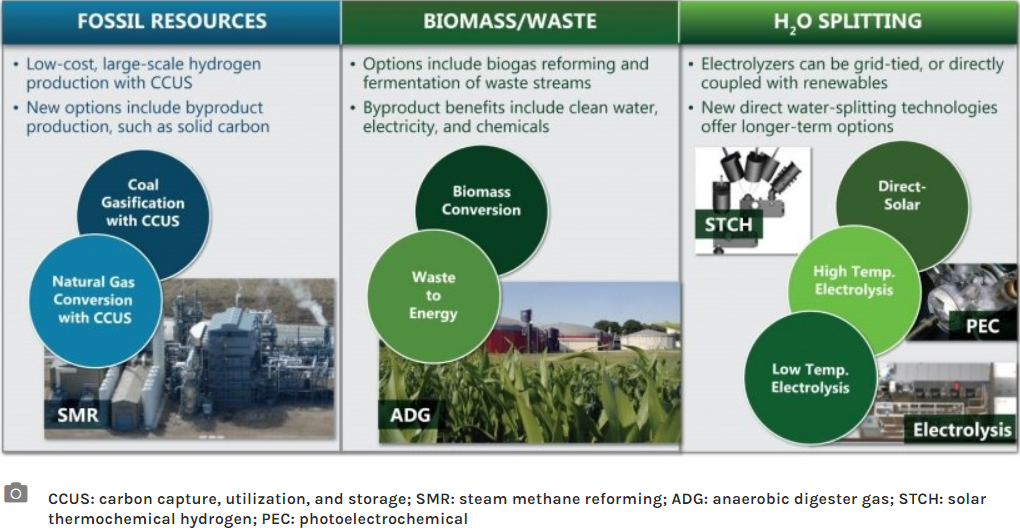| Author |
 Topic Search Topic Search  Topic Options Topic Options
|
Coke-in-MN 
Orange Level Access


Joined: 12 Sep 2009
Location: Afton MN
Points: 42006
|
 Post Options Post Options
 Thanks(0) Thanks(0)
 Quote Quote  Reply Reply
 Topic: Fuel Cell Technology Advancing Topic: Fuel Cell Technology Advancing
Posted: 19 Mar 2021 at 9:37am |
https://www.truckinginfo.com/10139099/qa-hyzons-big-plans-for-hydrogen-powered-commercial-vehicles?utm_source=email&utm_medium=enewsletter&utm_campaign=20210318-NL-HDT-HeadlineNews-BOBCD210312012&omdt=NL-HDT-HeadlineNews&omid=1009689398&utm_content=01&oly_enc_id=3348I0989123I8B
Fuel cell and Hydrogen - AC fuel cell coming to age of acceptance ? In the late 1990's and up to 2003 I worked with fuel cell plates for GM using Titanium plates within them but industry was looking for a cheaper material than Titanium and the processes needed to manufacture them - units we made parts for were about the size of a small overnight suitcase and developed around 200 HP Seems these units now being marketed for heavy truck use have went well beyond this - also nice to see in note the product is made in the US even though other areas of the world are the final destination.
|
|
Life lesson: If you’re being chased by a lion, you’re on a horse, to the left of you is a giraffe and on the right is a unicorn, what do you do? You stop drinking and get off the carousel.
|
 |
|
Sponsored Links
|
|
 |
jaybmiller 
Orange Level Access

Joined: 12 Sep 2009
Location: Greensville,Ont
Points: 24728
|
 Post Options Post Options
 Thanks(0) Thanks(0)
 Quote Quote  Reply Reply
 Posted: 19 Mar 2021 at 9:47am Posted: 19 Mar 2021 at 9:47am |
|
OK, I'll bite, just WHERE do they get the hydrogen for these hydrogen fuel cells ?
|
|
3 D-14s,A-C forklift, B-112
Kubota BX23S lil' TOOT( The Other Orange Tractor)
Never burn your bridges, unless you can walk on water
|
 |
steve(ill) 
Orange Level Access


Joined: 11 Sep 2009
Location: illinois
Points: 88193
|
 Post Options Post Options
 Thanks(0) Thanks(0)
 Quote Quote  Reply Reply
 Posted: 19 Mar 2021 at 9:50am Posted: 19 Mar 2021 at 9:50am |
JAY !! Details, Details..... always looking for the FACTS !!... Cant they have a FEEL GOOD, UNICORN, SNOWFLAKE MOMENT !! 
|
|
Like them all, but love the "B"s.
|
 |
steve(ill) 
Orange Level Access


Joined: 11 Sep 2009
Location: illinois
Points: 88193
|
 Post Options Post Options
 Thanks(0) Thanks(0)
 Quote Quote  Reply Reply
 Posted: 19 Mar 2021 at 9:52am Posted: 19 Mar 2021 at 9:52am |
n the early stages, [we're focusing on vehicles] that operate on a back-to-base model. So this can be urban transit buses that run a lot of hours a day and come back to a depot, concrete trucks that go out of a plant and come back in to a depot, cold chain logistics delivery type trucks that go out a refrigerated warehouse and do all their deliveries around a city and come back, refuse trucks that go out of a depot and come back.The use case for hydrogen in these kind of scenarios is really very compelling, because you're not dependent on the wider build-out of a hydrogen network to create viability at the fleet level. You just need one piece of hydrogen infrastructure.
|
|
Like them all, but love the "B"s.
|
 |
DMiller 
Orange Level Access

Joined: 14 Sep 2009
Location: Hermann, Mo
Points: 34161
|
 Post Options Post Options
 Thanks(0) Thanks(0)
 Quote Quote  Reply Reply
 Posted: 19 Mar 2021 at 10:31am Posted: 19 Mar 2021 at 10:31am |
95% of ALL commercially available Hydrogen comes from
Are ya Ready?
Patience
Here it Comes!!!
Natural Gas!!!
|
 |
DMiller 
Orange Level Access

Joined: 14 Sep 2009
Location: Hermann, Mo
Points: 34161
|
 Post Options Post Options
 Thanks(0) Thanks(0)
 Quote Quote  Reply Reply
 Posted: 19 Mar 2021 at 10:34am Posted: 19 Mar 2021 at 10:34am |
The byproducts are: CO and CO2
|
 |
Coke-in-MN 
Orange Level Access


Joined: 12 Sep 2009
Location: Afton MN
Points: 42006
|
 Post Options Post Options
 Thanks(0) Thanks(0)
 Quote Quote  Reply Reply
 Posted: 19 Mar 2021 at 5:05pm Posted: 19 Mar 2021 at 5:05pm |
By Product in H2O in conversion as water vapor Already being used in ice land and they have a fuel station arrangement
Methods of hydrogen production Main technologies for hydrogen production include natural gas steam reforming, partial oxidation and auto- thermal reforming of hydrocarbons or renewable fuels (e.g. bioethanol) as well as coal and biomass gasification, water electrolysis, thermo-chemical water splitting, and biological production processes.
Edited by Coke-in-MN - 19 Mar 2021 at 5:07pm
|
|
Life lesson: If you’re being chased by a lion, you’re on a horse, to the left of you is a giraffe and on the right is a unicorn, what do you do? You stop drinking and get off the carousel.
|
 |
Coke-in-MN 
Orange Level Access


Joined: 12 Sep 2009
Location: Afton MN
Points: 42006
|
 Post Options Post Options
 Thanks(0) Thanks(0)
 Quote Quote  Reply Reply
 Posted: 19 Mar 2021 at 5:16pm Posted: 19 Mar 2021 at 5:16pm |
https://www.eia.gov/energyexplained/hydrogen/production-of-hydrogen.php ydrogen explainedProduction of hydrogenHow is hydrogen produced?To produce hydrogen, it must be separated from the other elements in the molecules where it occurs. There are many different sources of hydrogen and ways for producing it for use as a fuel. The two most common methods for producing hydrogen are steam-methane reforming and electrolysis (splitting water with electricity. Researchers are exploring other methods. Hydrogen production processesSteam-methane reforming is a widely used method of commercial hydrogen productionSteam-methane reforming accounts for nearly all commercially produced hydrogen in the United States. Commercial hydrogen producers and petroleum refineries use steam-methane reforming to separate hydrogen atoms from carbon atoms in methane (CH4). In steam-methane reforming, high-temperature steam (1,300°F to 1,800°F) under 3–25 bar pressure (1 bar = 14.5 pounds per square inch) reacts with methane in the presence of a catalyst to produce hydrogen, carbon monoxide, and a relatively small amount of carbon dioxide. Natural gas is the main methane source for hydrogen production by industrial facilities and petroleum refineries. Landfill gas/biogas, which may be called biomethane, is a source of hydrogen for several fuel cell power plants in the United States. Biofuels and petroleum fuels are also potential methane sources. Electrolysis uses electricityElectrolysis is a process that splits hydrogen from water using an electric current. Electrolysis is commonly used to demonstrate chemical reactions and hydrogen production in high school science classes. On a large, commercial scale, the process may be referred to as power-to-gas, where power is electricity and hydrogen is gas. Electrolysis itself does not produce any byproducts or emissions other than hydrogen and oxygen. The electricity for electrolysis can come from renewable sources such as hydro, solar, or wind energy. If the electricity for electrolysis is produced from fossil fuel (coal, natural gas, and petroleum) or biomass combustion, then the related environmental effects and carbon dioxide emissions are indirectly associated with electrolysis. Other methods of producing hydrogenResearch is underway to develop other ways to produce hydrogen, such as - Using microbes that use light to make hydrogen
- Converting biomass into gas or liquids and separating the hydrogen
- Using solar energy technologies to split hydrogen from water molecules
Categories of hydrogenHydrogen producers, marketers, government agencies, and other organizations might categorize or define hydrogen according to the energy sources for its production. For example, hydrogen produced using renewable energy might be referred to as renewable hydrogen or green hydrogen. Hydrogen produced from coal may be called brown hydrogen, and hydrogen produced from natural gas or petroleum might be referred to as grey hydrogen. Brown or grey hydrogen production combined with carbon capture and storage/sequestration might be referred to as blue hydrogen. Last updated: January 7, 2021 |
|
Life lesson: If you’re being chased by a lion, you’re on a horse, to the left of you is a giraffe and on the right is a unicorn, what do you do? You stop drinking and get off the carousel.
|
 |









 Topic Options
Topic Options

 Post Options
Post Options Thanks(0)
Thanks(0)





